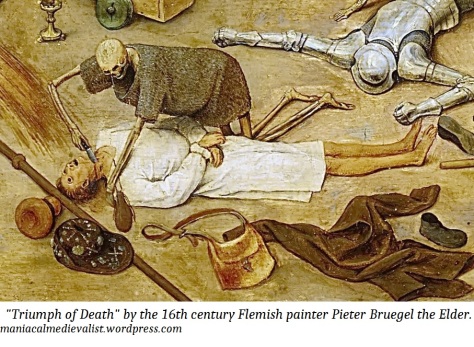My attitude is that you never should HAVE TO buy new fabric for children’s garb. You can find better and cheaper fabric by looking with a creative eye and an open mind at your local thrift store. At least that’s what I do.
Luckily for me, one of our local thrift shops (America’s Thrift) sorts everything by size. The easiest way to find good, period fabric, such as linen or wool, is to start with the largest sizes and work your way down.
For example, when I made this tunic: 
I searched through women’s clothing looking for the largest red linen shirt or skirt I could find. The red linen shirt, I settled on, was made with a very nice lightweight, tight weave linen. For the contrasting neck and sleeves, I found an off-white linen skirt. I wasn’t using much fabric for the contrast, so any size would have done fine. Both purchases together cost about $2.50 – I also look for deals even when thrift store shopping.
Little known thrift store tip, many, many people buy linen clothing because it looks great at the store with the sizing still on it. Then they don’t know how to care for the linen and get rid of it. I find countless brand new items of linen clothes all of the time. My entire mundane wardrobe is nearly all linen (I live in southern Louisiana, so do you blame me for wanting to stay cool?).
Once you get home with the item you are going to re-purpose, wash it well in warm water. And dry the heck out of it. Any warping of the fabric or fading of the dyes you want done before you cut it.

The linen shirt I found. I think it was either a 1X or a 2X in size. 100% nice linen.
Now iron it flat. Cut it along the seams into as many large flat pieces you can. Even if those pieces have seams, as long as it can lay flat, leave those seams in.

Blouse cut into flat pieces. There is still a seam running down the back piece, but since it laid flat, I left it.
Now use those pieces to cut the pieces you need for the item you are making.

Pieces for son’s Viking tunic. Reverse the front and back pieces – I confused them when labeling and am too lazy to relabel!
I have a method for patterning tunics using only the person’s measurements. I have an idea that all garb construction can be reduced to mathematical formulas. It’s just an idea right now, but one type of garb at a time I’m working the math out.
My tunic method mostly works. I still need to tweak it a bit in places, but I’ll definitely post my method once I have it just right. I used my method making this tunic, and it fit my son perfectly.

Mostly sewn tunic
After much experience, I found it easier to make the neckline before the sides are sewn up on a tunic.

Neck line basted onto tunic.
Each family member has a basic neck pattern for tunics and such. I make it with craft foam since it’s more durable and flexible than paper.
I also have a mathematical formula for making neck holes. I’m still working on that too.
Another tip, leave the center neck hole in the neck piece while basting it to the garment. It makes it much easier to pin the garment and neck together. Remember, pin the right side of the neck line to the wrong side of the shirt.

Neck hole trimmed
I cut the hole out of the neck. I’ll trim the seams a bit closer to make it fold over easier.

Keyhole neckline turned right side out
Turn the neck line piece so that the right side of it is showing on the right side of the tunic. I then placed a small row of stitches around the hole to stabilize the fabric. These stitches can be removed once you are done with the neck, but I left them on as decorative stitches.

Hemmed and finished.
I added a decorative row of blue stitches and another of white stitches along the edge to tack the hem down.

All that’s left is to sew up the sides.
Before I sew the sides and hem the bottom, if I want to add any embroidery or other embellishments, I do them now. It’s easier to embroider a flat piece than having to stick your hand in and out of a tunic.

finished tunic
Here it is all done. I did a bit of split stitch embroidery on the neck and cuffs to spruce it up.
Besides the embroidery, it took me all-in-all about 2 hours to make the tunic. My little dude loved it, and I’m very happy with it.
![]()













